The oceans cover approximately 70 per cent of the earth‚Äôs surface. Whether or not we know it, we all depend on the ocean. The ocean helps produce the oxygen we breathe, acts as a major transportation route for goods, is a major supplier of food and is a favourite place of outdoor enthusiasts. Őż
Even though the ocean plays such a major role in our everyday lives, there is still a lot for us to learn. Over 100 researchers across nine faculties at Dal are working every day to make new discoveries about the ocean. From basic science research to new technologies, Dalhousie’s internationally recognized researchers are creating global solutions to the complex challenges facing our life-sustaining oceans.
 ‚ÄúDal has the full package of ocean research,‚ÄĚ says Paul Hill, chair of the Department of Oceanography. ‚ÄúOur researchers are leading the way in social sciences, basic science and the development of new technologies. Together these areas of expertise allow Dal to deliver great education, great science and inform great policy decisions.‚ÄĚ
‚ÄúDal has the full package of ocean research,‚ÄĚ says Paul Hill, chair of the Department of Oceanography. ‚ÄúOur researchers are leading the way in social sciences, basic science and the development of new technologies. Together these areas of expertise allow Dal to deliver great education, great science and inform great policy decisions.‚ÄĚ
The ocean’s connections
The ocean is a complex environment, and its complexities grow as you examine at the role it plays with the rest of the world. As we discover new information about the ocean, we discover connections with the atmosphere, environment and human health. New discoveries also allow researchers to look at other areas ‚ÄĒ not only within the ocean, but non-marine environments as well to predict what may change or why things may have changed.
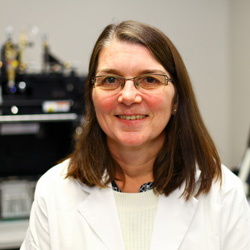 Julie LaRoche, a biology professor and Canada Research Chair in Marine Microbial Genomics and Biogeochemistry, is helping identify how changes in the ocean may affect the environment and marine organisms, by studying marine microbiomes.
Julie LaRoche, a biology professor and Canada Research Chair in Marine Microbial Genomics and Biogeochemistry, is helping identify how changes in the ocean may affect the environment and marine organisms, by studying marine microbiomes.
‚ÄúMicrobes are the dominant organisms on the planet,‚ÄĚ explains Dr. LaRoche. ‚ÄúThey are often the first organisms to adapt when a change it made to an environment. By studying how they change, we can identify what may be causing the change, why it‚Äôs happening and how it may impact other organisms such as fish populations.‚ÄĚ
By understanding how marine environments are changing we can work to reduce environmental impacts and ensure species health.
The ocean also consists of particles, found in everything from ocean spray to ships, connecting the ocean to our atmosphere. Once in the atmosphere, particles play a key role in our climate affecting the environment and human health.
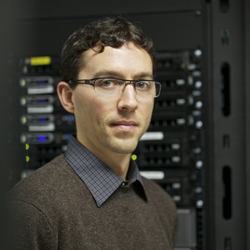 ‚ÄúThe atmosphere and ocean are connected in a variety of ways such that progress in understanding either one benefits the other,‚ÄĚ says Randall Martin, professor in the Department of Physics and Atmospheric Science and in Department of Chemistry. ‚ÄúBy applying a combination of satellite remote sensing, chemical transport modeling, and in situ measurements, we can gain insight into what the future climate may look like and use this information to see how the change may impact local, national and international environments.‚ÄĚ
‚ÄúThe atmosphere and ocean are connected in a variety of ways such that progress in understanding either one benefits the other,‚ÄĚ says Randall Martin, professor in the Department of Physics and Atmospheric Science and in Department of Chemistry. ‚ÄúBy applying a combination of satellite remote sensing, chemical transport modeling, and in situ measurements, we can gain insight into what the future climate may look like and use this information to see how the change may impact local, national and international environments.‚ÄĚ
The marine ecosystem’s complexities make it difficult to understand and predict how it is changing under pressures from human activities and climate variation.
Sara Iverson, professor in Biology and scientific director of the Ocean Tracking Network, studies marine mammals, seabirds and fishes to learn about the impacts of changing oceans on their populations.
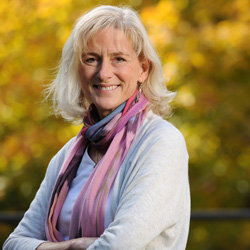 ‚ÄúMarine ecosystems can be altered by many factors, including climate change and fisheries activities,‚ÄĚ explains Dr. Iverson. ‚ÄúAs ecosystems evolve, the abundance, distribution, interactions, and survival of marine species also change.‚ÄĚ
‚ÄúMarine ecosystems can be altered by many factors, including climate change and fisheries activities,‚ÄĚ explains Dr. Iverson. ‚ÄúAs ecosystems evolve, the abundance, distribution, interactions, and survival of marine species also change.‚ÄĚ
Tracking technology helps Dr. Iverson understand how marine species move through their underwater world, with whom they interact, how they survive, and how they react to environmental change. The results can then be used to devise ways to help protect these species and yet still look to the oceans as a major food source.
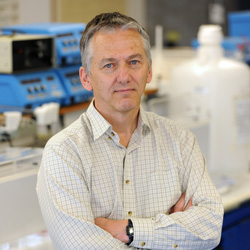 Paul Bentzen, a professor in the Department of Biology, is developing tools that identify the diverse populations that make up Canada’s fisheries, where they occur, and how much mixing occurs between them. This information allows the fisheries to target individual populations in a controlled fashion.
Paul Bentzen, a professor in the Department of Biology, is developing tools that identify the diverse populations that make up Canada’s fisheries, where they occur, and how much mixing occurs between them. This information allows the fisheries to target individual populations in a controlled fashion.
‚ÄúBy developing novel software tools and improving existing software we can ease analysis of the huge amounts of data involved, and enable management of mixed-stock fisheries and conservation of biodiversity within economically and culturally important fish species,‚ÄĚ says Dr. Bentzen.
This information will help the fisheries be more productive, stable, and subject to fewer closures.
The ocean also connects us to one another: in fact, 90 per cent of world trade is done through shipping.
 ‚ÄúInternational navigation, sustainable shipping and trade rely on uniform rules,‚ÄĚ explains Aldo Chircop, a professor at the Schulich School of Law and MELAW‚Äôs Associate Director. ‚ÄúI explore factors that facilitate or constrain uniform standards and their enforcement in shipping, and how international and Canadian maritime law can be further developed and harmonized.‚ÄĚ
‚ÄúInternational navigation, sustainable shipping and trade rely on uniform rules,‚ÄĚ explains Aldo Chircop, a professor at the Schulich School of Law and MELAW‚Äôs Associate Director. ‚ÄúI explore factors that facilitate or constrain uniform standards and their enforcement in shipping, and how international and Canadian maritime law can be further developed and harmonized.‚ÄĚ
By identifying issues that call for international and Canadian maritime regulatory reform, we can develop policies needed for safe shipping practices, that will help support the global economy.
The power of collaboration
At Dal, researchers are collaborating across departments, faculties, institutions and industry. Through collaborations, researchers are providing Nova Scotia and Canada with the ability to innovate, commercialize and impact public policy.
One driver for collaboration is the large amount of information being gathered on ocean research from around the world. Advances in acquisition, management and analysis are needed to help understand and manage the diverse range of information.
 Stan Matwin, a professor in the Faculty of Computer Science and Canada Research Chair in Visual Text Analytics, is applying his big data analysis research to help ocean researchers answer questions concerning complexities of the ocean.
Stan Matwin, a professor in the Faculty of Computer Science and Canada Research Chair in Visual Text Analytics, is applying his big data analysis research to help ocean researchers answer questions concerning complexities of the ocean.
One area of research has Dr. Matwin collaborating with researcher Boris Worm’s lab in the Department of Biology. Dr. Matwin is looking at the analysis of ship trajectories by using information from the ships Automatic Identification System (AIS) to mine interesting facts, regularities and anomalies. The information can help identify ships travel patterns and whether or not a trawler is fishing.
Researchers in Boris Worm's lab are using the information to see how fishing fleets are behaving around marine protected areas worldwide, while industry is using it to develop modelling software to improve transportation.
Collaboration also comes from a need for research technology to support the growing areas of ocean research.
 ‚ÄúIn working closely with ocean scientists we can develop the technology they need to expand their research scope and capabilities,‚ÄĚ says Zhizhang (David) Chen, head of the Department of Electrical and Computer Engineering. ‚ÄúResearchers in our Faculty are leading the way in areas of underwater acoustic communications and sensing as well as marine robots.‚ÄĚ
‚ÄúIn working closely with ocean scientists we can develop the technology they need to expand their research scope and capabilities,‚ÄĚ says Zhizhang (David) Chen, head of the Department of Electrical and Computer Engineering. ‚ÄúResearchers in our Faculty are leading the way in areas of underwater acoustic communications and sensing as well as marine robots.‚ÄĚ
The research technology can be applied to the real-time monitoring of the ocean environment. This allows for fast extraction of biogeochemistry data for understanding the state of the oceans, operations of search and rescue missions, and discovering of new marine phenomena by allowing researchers to look further and deeper into the oceans than before.
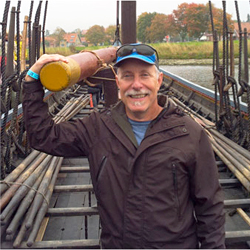 Industry is also driving collaboration at Dal. Jon Grant, a professor in the Department of Oceanography and NSERC-Cooke Industrial Research Chair in Sustainable Aquaculture, brings novel approaches to the aquaculture industry. Using mathematical models, Jon can predict where a fish farm should be placed, how it may impact the marine ecosystem and how the industry can be more sustainable in its practices and growth. He also works with collaboratively with other researchers across Dal’s Faculties to help answer questions around the industry.
Industry is also driving collaboration at Dal. Jon Grant, a professor in the Department of Oceanography and NSERC-Cooke Industrial Research Chair in Sustainable Aquaculture, brings novel approaches to the aquaculture industry. Using mathematical models, Jon can predict where a fish farm should be placed, how it may impact the marine ecosystem and how the industry can be more sustainable in its practices and growth. He also works with collaboratively with other researchers across Dal’s Faculties to help answer questions around the industry.
‚ÄúI was approached by industry with the concern of farmed fish escaping their enclosures and interacting with wild fish,‚ÄĚ says Dr. Grant. ‚ÄúI helped them engage Darrel Doman in the Faculty of Engineering to measure stress factors on enclosures and help improve cage design.‚ÄĚ
Őż
By using research to understand more about aquaculture, industry and environmental concerns can be prevented and mitigated for a more sustainable food future.
Őż
‚ÄúOur research findings can be applied to understand how aquaculture can fit into the marine ecosystem without impacting other areas of fisheries or the environment,‚ÄĚ says Dr. Grant. ‚ÄúIt can also be applied to how the industry growth can not only be sustainable, but also a benefit to our economy. Cooke Aquaculture is an excellent partner in these endeavors.‚ÄĚ
Research in the ‚Äėblue economy‚Äô
The ocean is a large driver of our economy. It provides transportation, living and non-living resources. To safely and sustainably access and utilize these resources, we need to better understand the processes of the ocean.
‚ÄúDal is located not only in a province, but a country with fantastic ocean resources that can benefit our economy,‚ÄĚ says Dr. Hill. ‚ÄúHowever Canada‚Äôs blue economy underperforms with only 2 per cent of our GDP coming from the ocean sector, where other countries have 4-5 per cent.
‚ÄúWe need to expand this area and Dal is poised to help Nova Scotia and Canada do so. Our researchers are making the discoveries that will help us make good decisions for the future as we continue to use the great ocean resource wisely and safely.‚ÄĚ

